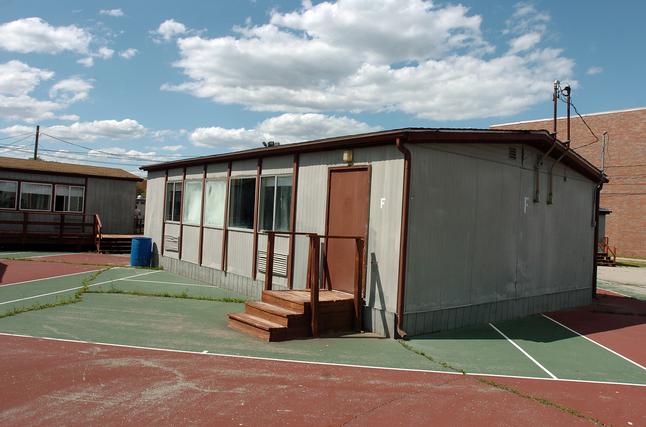Clik here to view.

The portable classrooms behind the E-Hall at Pioneer High School, pictured in this Ann Arbor News file photo, were removed in 2009 as part of a wide-ranging construction project paid for by the district's sinking fund and comprehensive improvement bond. The district plans to go out for another sinking fund millage renewal within the next year.
The Ann Arbor News | File Photo
State Rep. Adam Zemke, D-Ann Arbor, introduced legislation last week that would allow school officials to use sinking fund money to invest in safety measures and security equipment.
Clik here to view.

Adam Zemke
Sinking funds are voter-approved pools of money intended to maintain the liquid assets of a school district or other public entity. State law allows school districts to levy up to 5 mills in property taxes for no longer than 20 years.
The Ann Arbor Public Schools sinking fund millage last was renewed by voters in 2008. Ann Arbor's sinking fund levies 1 mil and enables the district to spend taxpayers' money as soon as it is collected, unlike a bond millage, which involves the district borrowing the full amount of the bond upfront from a third-party lender.
Bonds can be used to pay for capital projects, such as new building construction, technology purchases and furniture. Sinking funds may only be used for capital improvement or enhancement projects, such as:
- Purchasing real estate
- Remodeling, repairing or purchasing facilities, but not for the maintenance of facilities
- Acquiring or improving sites for school buildings, athletic facilities and playgrounds etc.
- Technology infrastructure, like wiring and other materials used for installation, but not for equipment or software.
Ann Arbor's sinking fund millage expires in 2014. A contingent of Ann Arbor school board members have committed to putting together a campaign for the millage renewal as part of the board's financial goal for the 2012-13 academic year.
Zemke said the package of bills he is working on is about removing state restrictions on locally generated funds and restoring local control so school officials have more flexibility in how to spend their limited resources and "to make their dollars stretch further."
"Recent years of painful funding cuts from state government have resulted in instability and unpredictability for schools, making it increasingly difficult for districts to take the steps necessary to keep students safe," Zemke said.
He added: "After the tragic events in (Newtown) Connecticut late last year, it's more important than ever that we provide a safe and secure environment where children can learn."
Zemke said the inability to fund building renovations for security improvements was something Saline Area Schools Superintendent Scot Graden spoke to him about. Saline has a desire to reconfigure a few of its buildings where the primary entrances are not visible from the main office, Zemke said.
"I personally think the State Legislature needs to be very supportive of K-12 education. It's heartbreaking to go board meetings and hear the deficits school board members are talking about. They're not small numbers. And it's year after year. It's taking away from the educational experiences of students," Zemke said.
Ann Arbor Public Schools Board President Deb Mexicotte was encouraged by the package of bills being introduced in the House.
Clik here to view.

Deb Mexicotte
"More and more as we find ourselves looking at things to minimize cuts to the classroom, we are looking at transportation and/or busing," she said. "We are not allowed to charge for busing on any level, so to be able to shift some sinking fund money toward anything transportation related would be welcome."
Voters in the Ann Arbor Public Schools also approved a $45.8 million bond for technology in May 2011 partially because the district could not use sinking fund dollars to replace outdated technology.
When voters first approved the district's sinking fund millage in 2004, it was passed in tandem with a $255 million comprehensive school improvement bond that provided funds for building Skyline High School as well as for upgrades to each of the district's existing school facilities.
In a recent report to the Board of Education, AAPS Executive Director of Physical Properties Randy Trent said the district may want to consider a combination bond/sinking fund again when it goes out for its next millage renewal. Trent said one reason is because of the restrictions placed on both types of funding.
He said if school officials asked voters to approve a bond/sinking fund combination for the same taxable value of 1 mil, the district would have the flexibility to address classroom furniture and equipment issues that currently it cannot. Trent said the district has a need to replace existing classroom desks, tables, chairs, office and lunchroom furniture to the tune of $5 million.
While not knowing yet the specifics of the sinking fund bills being proposed, Mexicotte said the bills could have the potential to prevent AAPS from having to issue bonds along with its sinking fund renewal.
She said sinking fund millages are more easily understood and can be done in shorter intervals to allow the public to weigh in on how much the district needs. Bonds are more of a long-term commitment and require years of debt management for what the district can gain now, she said.
Mexicotte added with technology, bonds are rather inconvenient because technology has such a short shelf life that many districts could still be paying for their last technology purchases well beyond when they need to upgrade again. She said Ann Arbor's current technology bonds are being issued over the course of 10 years in three separate series to minimize such issues.
Recent data show the district has a sinking fund balance of about $1.84 million. That money has been allocated for bus purchases but will depend on what school officials decide to do with transportation in new year's budget. Cuts to transportation have again been proposed for 2013-14, including: Renegotiating gas purchase costs for transportation, $100,000. Eliminating high school transportation, $466,000. Eliminating middle school transportation, $1.2 million.
Danielle Arndt covers K-12 education for AnnArbor.com. Follow her on Twitter @DanielleArndt or email her at daniellearndt@annarbor.com.